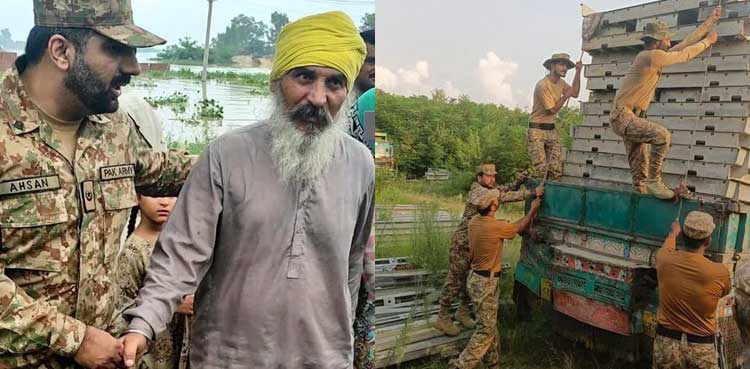India’s reckless water releases have turned Pakistan’s flood crisis into a man-made catastrophe in August 2025. Pakistan rightfully accuses India of waging a “water flood war” by unleashing torrents from the Thein and Madhopur Dams on the Ravi River, exacerbating Punjab’s flooding. Sialkot’s 363.5mm rainfall, combined with these unannounced releases, has overwhelmed Nullah Aik at 46,950 cusecs—nearly double its capacity. The Sutlej River’s surge to 2.4 lakh cusecs at Hussainiwala Headworks has inundated 35 villages in Ferozepur and 20 in Fazilka, displacing thousands.
Pakistan’s Provincial Disaster Management Authority condemns India’s lack of prior warning, which has stretched the Army’s relief efforts—evacuations, embankment fortifications, and medical camps—to the brink in Punjab, home to half of Pakistan’s 240 million people.
Pakistan Floods- All Updates
The rain hammers down, and Pakistan is submerged. It’s August 27, 2025, and catastrophic floods have ravaged Khyber Pakhtunkhwa (KPK), Punjab, Sindh, and Balochistan, leaving behind a trail of devastation. As a journalist witnessed the relief operation of Pakistan Army, I’ve witnessed through KPK’s mud, navigated Punjab’s swollen rivers, waded through Sindh’s inundated fields, and witnessed Balochistan’s stark recovery efforts. In the last 24 hours, Punjab alone has been battered by record-breaking rainfall, with Sialkot recording 363.5mm—the heaviest in 49 years. The Army’s relief operations are a lifeline, their resolve a testament to duty forged in crisis.
In KPK, Buner is a scene of heartbreak. Mudslides have buried entire villages, and the Swat Valley is a wreckage of shattered homes. I witnessed the Corps of Engineers in Pir Baba, where soldiers clear debris from the bypass road under torrential rain. A young lieutenant, his uniform soaked, directs a bulldozer through rubble. “We’re racing against time,” he says, his eyes scanning for stranded families. They’ve restored the 20-kilometer Aloch-Puran road, choked by landslides at seven points, ensuring aid reaches remote hamlets. Helicopters hum overhead, airlifting families from Khawazakhela’s cliffs. I saw a sortie from Kanju Cantt, watching a pilot navigate swirling winds to drop rations to a family perched on a hillside. The mother’s tearful wave as we lift off is etched in my memory.
Punjab is a deluge, with Sialkot, Lahore, and border districts like Ferozepur and Fazilka reeling from the past 24 hours’ chaos. Sialkot’s 363.5mm rainfall has turned streets into rivers, with Nullah Aik overflowing at 46,950 cusecs—nearly double its capacity. In Lahore, I wade through flooded streets with an Army unit, watching a private carry an elderly man to a boat. “We’ll get you to safety,” he says, his voice steady despite exhaustion. In Ferozepur, where the Sutlej River surged to 2.4 lakh cusecs at Hussainiwala Headworks, the Army evacuated over 200 people from 35 villages. Fazilka’s relief camps shelter families from 20 inundated villages, with soldiers distributing steaming plates of rice and blankets. In Kasur, I saw a medical camp where doctors treat waterborne illnesses, their tents a haven for displaced mothers. The Army’s special flood units, deployed across Sialkot, Lahore, Gujranwala, Faisalabad, Chiniot, and Muzaffargarh, work tirelessly. In Narowal, Nullah Basantar’s flooding keeps soldiers on alert, while in Fazilka, a 30-foot breach in a defense drain prompts nighttime repairs under floodlights. In Sialkot, the Chenab River’s 902,224 cusecs at Head Marala has Army teams fortifying embankments to prevent further disaster.
Sindh’s flatlands are a sea of misery, with Khairpur and Thatta hit hardest. In Hyderabad, I walk through a relief camp where the Army serves hot meals to thousands. A grizzled sergeant hands a blanket to a shivering child, his smile a rare light in the gloom. Medical camps in Badin and Sujawal buzz with activity; I see a doctor stitch a farmer’s wound, his calm easing the man’s fear. Army boats navigate flooded channels, rescuing families from rooftops in Umerkot. A soldier recounts saving an elderly couple trapped for three days, their gratitude humbling him. The Army’s presence here is a steady pulse, delivering aid with precision and care.
Balochistan’s rugged terrain tests even the toughest. In Quetta, I saw a camp where soldiers unload sacks of flour for families who’ve lost everything. In Sibi, Frontier Corps troops trek through muddy paths to reach Dera Bugti, their packs heavy with supplies. A K-9 unit sniffs through debris in Bela, searching for survivors, while engineers repair washed-out bridges. A local elder grips a soldier’s hand, saying, “You’re our family now.” The Army’s grit is palpable, bridging isolation and despair.
The Army’s operation spans hundreds of relief points, channeling food, water, and shelter to millions. In every province, soldiers share the people’s burden—shoveling mud in Punjab’s Bishnoi, playing with children in Sindh’s camps, carrying supplies in Balochistan’s hills, or handing biscuits to a wide-eyed boy in Charsadda. These floods, fueled by climate-driven glacial melt and relentless rains, have exposed Pakistan’s fragility. Yet, the Pakistan Army’s heart shines through. At Sialkot camp, a soldier’s words echo: “We stay until the last person is safe.” In this deluge, they are Pakistan’s unbreakable spine, proving humanity endures.
In the chaos of August 2025, when the water rose to wash everything away, the Army became the human chain that refused to break. They were everywhere at once, a swift response that wasn’t about strategy, but about people. You could see it in the hands of the engineers pushing through mud in KPK, and in the exhausted determination of the soldiers saving a village in Punjab. This crisis is a hard lesson about our vulnerability, one that demands we do more than just rebuild. But the Army’s work was more than just preventing collapse; it was about showing up. They showed that while floodwaters can swallow bridges and roads, the spirit of duty is unbreakable. Every rescue, every meal served, was a simple promise spoken without words: in your worst moment, we will not leave you.

Leave a Reply